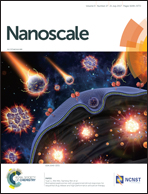High-density defects on PdAg nanowire networks as catalytic hot spots for efficient dehydrogenation of formic acid and reduction of nitrate†
Abstract
Controlling the surface defects of nanocrystals is a new way of tuning/boosting their catalytic properties. Herein, we report networked PdAg nanowires (NWs) with high-density defects as catalytic hot spots for efficient catalytic dehydrogenation of formic acid (FA) and catalytic reduction of nitrates. The networked PdAg NWs exhibit composition-dependent catalytic activity for the dehydrogenation reaction of FA without any additive, with Pd5Ag5 NWs exhibiting the highest activity. They also show good durability, reflected by the retention of their initial activity during the dehydrogenation reaction of FA even after five cycles. Their initial TOF is 419 h−1 at 60 °C in water solution, much higher than those of the most Pd-based catalysts with a support. Moreover, they can efficiently reduce nitrates to alleviate nitrate pollution in water (conversion yield >99%). This strategy opens up a new green synthetic technique to design support-free heterogeneous catalysts with high-density defects as catalytic hot spots for efficient dehydrogenation catalysis of FA to meet the requirement of fuel cell applications and catalytic reduction of nitrates in water polluted with nitrates.



 Please wait while we load your content...
Please wait while we load your content...